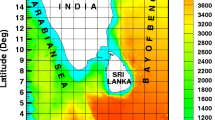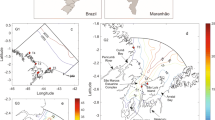Abstract
Tidal hydrodynamics of the Gulf of Khambhat (GoK) were studied with the observed and simulated datasets. The flushing time of the Gulf was estimated using the 2D-model calibrated and validated with the tide and current speed observations. Model simulations were carried out with the influence of tide, wind, and tide and wind combinedly. Wind-driven flushing was found to be the least with the flushing time magnitude of more than 25 days. The flushing time was found to be much lower for the surrounding sea irrespective of the seasonal and tidal variations. The model-derived tidal circulation revealed the seasonal variability and the dominance of flood tide over ebb in GoK. Maximum current speed was during spring-flood conditions in the southwest monsoon, whereas minimum current speed was during the neap-ebb condition of pre-monsoon. High-frequency radar data, from the southern GoK ascertain the increase in current speed from south to north. The Simpson–Hunter parameter, calculated in several locations of the Gulf established the enhancing mixing capacity of GoK from south to north. During low current speed conditions, the Gulf experiences the formation of a barrier at the southern region which interrupts flushing between the Gulf and the north-eastern Arabian Sea during northeast monsoon and pre-monsoon season.
Highlights
-
Tidal hydrodynamics of Gulf of Khambhat studied with the observed and simulated datasets
-
Amplification in the mixing capacity of the Gulf is observed towards the north
-
Least flushing was observed during pre-monsoonal months










Similar content being viewed by others
References
Alber M and Sheldon J E 1999 Use of a date-specific method to examine variability in the flushing times of Georgia estuaries; Estuar. Coast. Shelf Sci. 49 469–482.
Anonymous 2017 Indian tide table: Indian and selected foreign ports; Survey of India, Government of India, Dehradun, India.
Balachandran K K, Reddy G S, Revichandran C, Srinivas K, Vijayan P R and Thottam T J 2008 Modelling of tidal hydrodynamics for a tropical ecosystem with implications for pollutant dispersion (Cochin Estuary, Southwest India); Ocean Dyn. 58 259–273, https://doi.org/10.1007/s10236-008-0153-6.
Brodie J, Wolanski E, Lewis S and Bainbridge Z 2012 An assessment of residence times of land-sourced contaminants in the Great Barrier Reef lagoon and the implications for management and reef recovery; Mar. Pollut. Bull. 65 267–279, https://doi.org/10.1016/j.marpolbul.2011.12.011.
Brunner K and Lwiza K M M 2020 Tidal velocities on the Mid-Atlantic Bight continental shelf using high-frequency radar; J. Oceanogr. 76 289–306, https://doi.org/10.1007/s10872-020-00545-7.
Cowell P J 2003 The coastal tract: Part 1: A conceptual approach to aggregated modeling of low-order coastal change; J. Coast. Res. 19 812–827.
Hersbach H, Bell B, Berrisford P et al. 2020 The ERA5 global reanalysis; Quart. J. Roy. Meteorol. Soc. 146 1999–2049, https://doi.org/10.1002/qj.3803.
Joseph A, Vijaykumar K, Mehra P, Unnikrishnan A S, Sundar D and Prabhudesai R G 2009 Observed tides at Mumbai High offshore region near the continental shelf break in the eastern Arabian Sea; Curr. Sci. 96(9) 1233–1235, http://drs.nio.org/drs/handle/2264/3351.
Kumar V S and Kumar K A 2010 Waves and currents in tide dominated location off Dahej. Gulf of Khambhat; Mar. Geodesy 33 218–231, https://doi.org/10.1080/01490419.2010.492299.
Laws E A 2013 Evaluation of in situ phytoplankton growth rates: A synthesis of data from varied approaches; Ann. Rev. Mar. Sci. 5 247–268.
Lee J H W and Wong P P S 1997 A water quality model for mariculture management; J. Environ. Eng. ASCE 123(11) 1136–1141.
Lucas L V, Koseff J R, Monismith S G, Cloern J E and Thompson J K 1999 Processes governing phytoplankton blooms in estuaries. 11: The role of horizontal transport; Mar. Ecol. Progr. Ser. 187 17–30.
Lucas L V 2010 Implications of estuarine transport for water quality; In: Contemporary issues in Estuarine Physics (ed.) Valle-Levinson A, Cambridge University Press, Cambridge, UK, ISBN: 9780521899673.
Luff R and Pohlmann T 1995 Calculation of water exchange times in the ICES-boxes with a Eulerian dispersion model using a half-life time approach; Deutsch. Hydrol. Z. 47 287–299.
Luketina D 1998 Simple tidal prism models revisited; Estuar. Coast. Shelf Sci. 46 47–84.
Mitra A, Kumar V S and Naidu V S 2020a Circulation in the Gulf of Khambhat – A Lagrangian Perspective; J. Mar. Sci. Eng. 8 25, https://doi.org/10.3390/jmse8010025.
Mitra A, Kumar V S and Jena B K 2020b Tidal characteristics in the Gulf of Khambhat, northern Arabian Sea-based on observation and global tidal model data; Oceanologia 62 443–459, https://doi.org/10.1016/j.oceano.2020.05.002.
Mitra A and Kumar V S 2021 A numerical investigation on the tide-induced residence time and its association with the suspended sediment concentration in Gulf of Khambhat, northern Arabian Sea; Mar. Pollut. Bull. 163 111947, https://doi.org/10.1016/j.marpolbul.2020.111947.
Monsen N E, Cloern J E and Lucas L V 2002 A comment on the use of flushing time, residence time, and age as transport time scales; Limnol. Oceanogr. 47(5) 1545–1553, https://doi.org/10.4319/lo.2002.47.5.1545.
Naidu V S and Sarma R V 2001 Numerical modeling of tide-induced currents in Thane creek, west coast of India; J. Waterw. Port Coast. Ocean Eng. 127 241–244, https://doi.org/10.1061/(ASCE)0733-950X(2001)127:4(241).
Naidu V S, Thomas J, Bari S and Kachave S 2016 The impact of dredging on residence time in the Amba estuary, west coast of India; Environ. Earth Sci. 75 108, https://doi.org/10.1007/s12665-015-4851-3.
Nayak R K and Shetye S R 2003 Tides in the Gulf of Khambhat, west coast of India; Estuar. Coast. Shelf Sci. 57 249–254, https://doi.org/10.1016/S0272-7714(02)00349-9.
Prandle D 1984 A modeling study of the mixing of 137Cs in the seas of the European continental shelf; Philos. Trans. Roy. Soc. Lond. A 310 407–436.
Revichandran C and Pylee A 1998 Mixing and flushing time scales of Azhikode estuary, southwest coast of India; Indian J. Mar. Sci. 27 163–166.
Ricker M and Stanev E V 2020 Circulation of the European northwest shelf: A Lagrangian perspective; Ocean Sci. 16 637–655, https://doi.org/10.5194/os-16-637-2020.
Sadrinasab M and Kampf J 2004 Three-dimensional flushing times of the Persian Gulf; Geophys. Res. Lett. 31 L24301, https://doi.org/10.1029/2004GL020425.
Sridevi B, Sarma V V S S, Murty T V R, Sadhuram Y, Reddy N P C, Vijayakumar K, Raju N S N, Jawahar K C H, Raju Y S N, Luis R, Kumar M D and Prasad K V S R 2015 Variability in stratification and flushing times of the Gautami-Godavari estuary, India; J. Earth Syst. Sci. 124(5) 993–1003.
Simpson J and Hunter J 1974 Fronts in Irish sea; Nature 250(5465) 404.
Stoker J J 1957 Water Waves; Interscience Publishers, New York, NY, USA.
Takeoka H 1984 Fundamental concepts of exchange and transport time scales in a coastal sea; Cont. Shelf Res. 3 311–326.
Thomann R and Muller J 1987 Principle of surface water quality modeling and control; Harper & Row Publishers, 621p.
Unnikrishnan A S, Shetye S R and Gouveia A D 1997 Tidal propagation in the Mandovi-Zuari estuarine network, west coast of India: Impact of freshwater influx; Estuar. Coast. Shelf Sci. 45 737–744.
Unnikrishnan A S, Shetye S R and Michael G S 1999 Tidal propagation in the Gulf of Khambhat, Bombay High and surrounding areas; Proc. Indian Acad. Sci. (Earth Planet. Sci.) 108 155–177, https://doi.org/10.1007/BF02842329.
Valle-Levinson A 2010 Contemporary Issues in Estuarine Physics; Cambridge University Press, United Kingdom, 315p.
Vinita J, Shivaprasad A, Revichandran C, Manoj N T, Muraleedharan K R and Binzy J 2015 Salinity response to seasonal runoff in a complex estuarine system (Cochin Estuary, West Coast of India); J. Coast. Res. 31(4) 869–878.
Winter G, Castelle B, Lowe R J, Hansen J E and McCall R 2020 When is flow re-entrainment important for the flushing time in coastal reef systems?; Cont. Shelf Res. 206 104194.
Zimmerman J T F 1976 Mixing and flushing of tidal embayments in the western Dutch Wadden Sea. Part I: Distribution of salinity and calculation of mixing time scales; Neth. J. Sea Res. 10 149–191.
Acknowledgements
The ADCP and HFR data used in the study are provided by the National Institute of Ocean Technology, Chennai. We thank the Director, National Institute of Ocean Technology, Chennai and Dr B K Jena, Scientist G, National Institute of Technology (Ministry of Earth Sciences), Chennai, for helping with the ADCP and HFR data. The authors thank Dr V S Naidu for the support provided to carry out the model simulations. Director, CSIR-National Institute of Oceanography, Goa provided facilities to carry out the study. We thank all colleagues for the help provided during the field data collection. We thank the reviewers for the comments and suggestions, which improved the scientific content of the paper. This is NIO contribution 6681 and forms a part of the PhD thesis of the first author. The first author wishes to acknowledge the Council of Scientific & Industrial Research, New Delhi for the award of a Senior Research Fellowship.
Author information
Authors and Affiliations
Contributions
Aditi Mitra: Conceptualization, formal analysis and original draft. Sanil Kumar: Supervision, writing-review and editing.
Corresponding author
Additional information
Communicated by C Gnanaseelan
This article is part of the topical collection: Advances in Coastal Research.
Rights and permissions
About this article
Cite this article
Mitra, A., Kumar, V.S. Tidal hydrodynamics and flushing characteristics of Gulf of Khambhat, west coast of India – A numerical approach. J Earth Syst Sci 130, 112 (2021). https://doi.org/10.1007/s12040-021-01601-6
Received:
Revised:
Accepted:
Published:
DOI: https://doi.org/10.1007/s12040-021-01601-6




